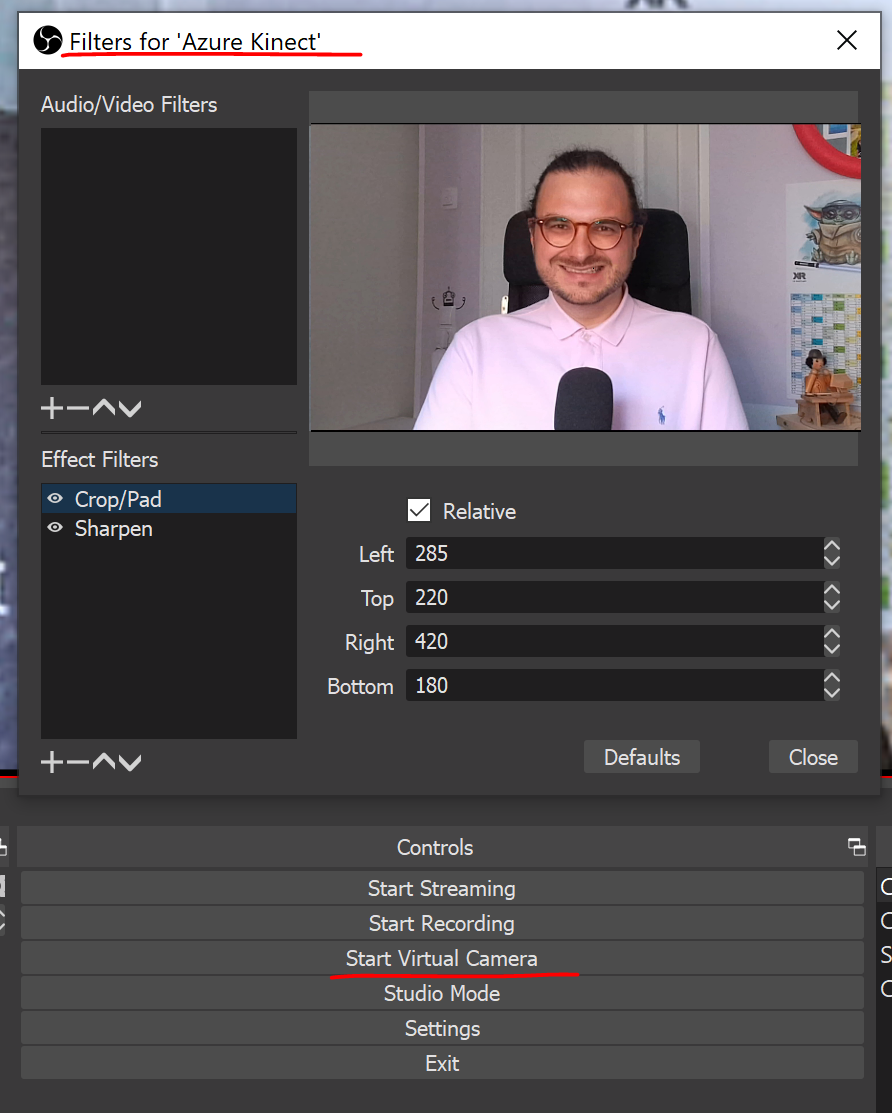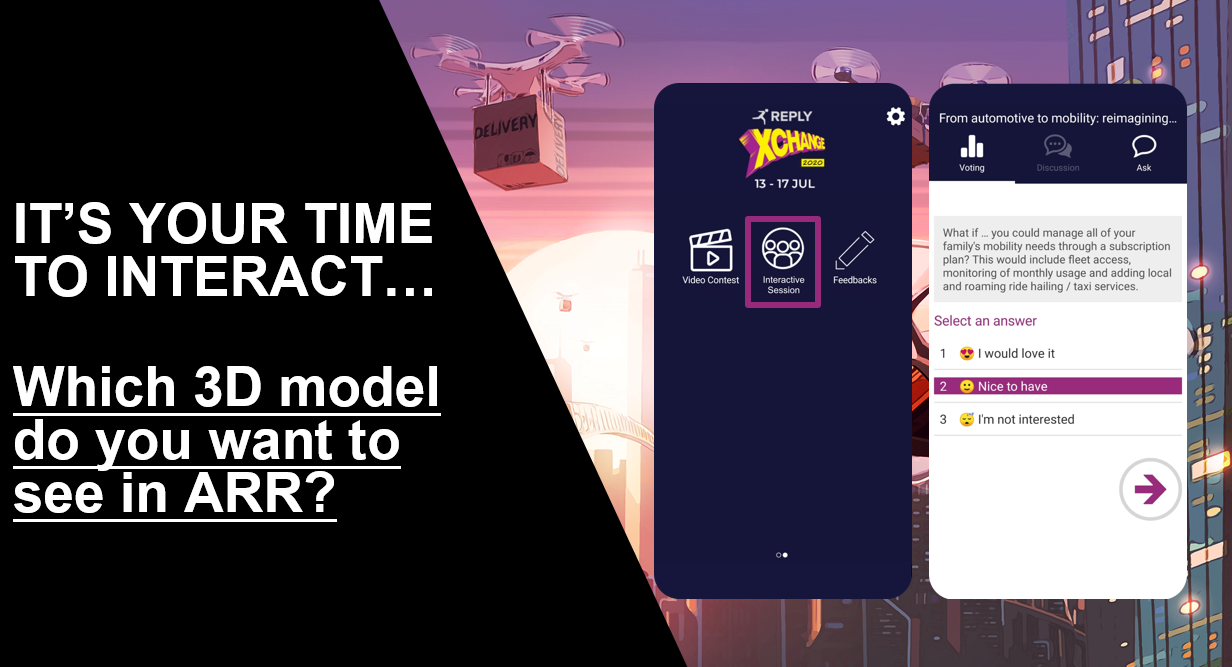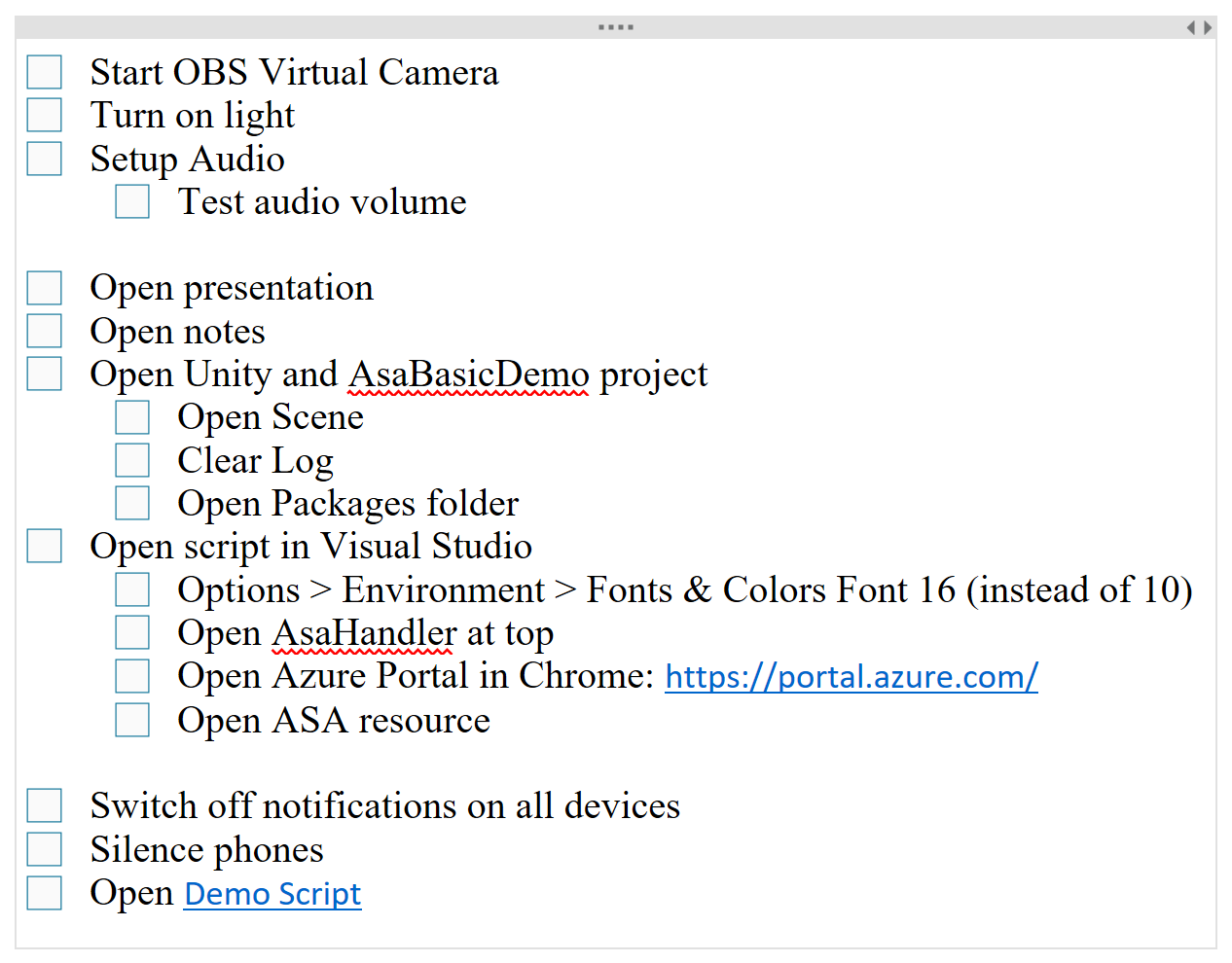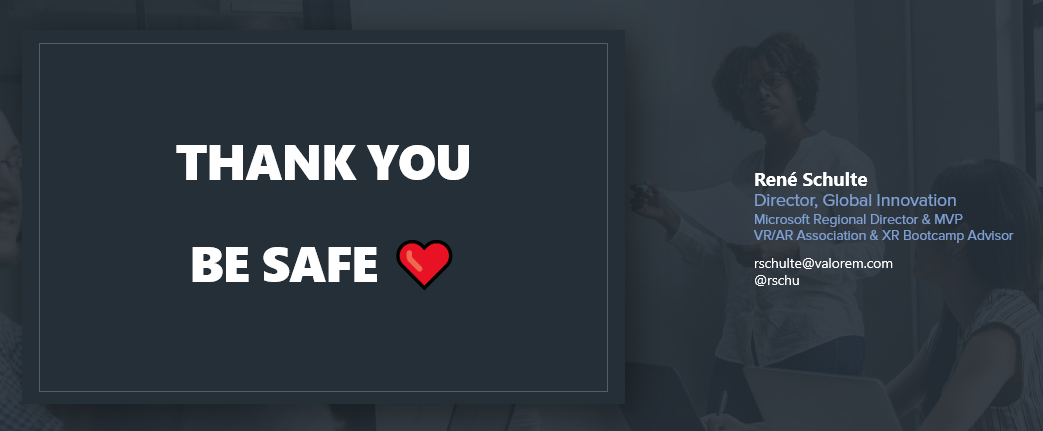The end of the year is approaching quickly and 2020 has surely been a challenging year for many, including conference speakers and even more so conference organizers. For me most of my speaking engagements have turned virtual / online and I recently finished my last speaking engagement of the year. This makes it a total of 30 sessions at various virtual events I have presented at since COVID-19 turned our world upside down. Based on this experience I wanted to share my lessons learned and best practices I have gathered.
1. Invest in Your SetupOne basically needs 5 things for a live presentation (or for recording): PC, webcam, light, microphone, and internet. You want to be seen and heard well in your talk. Make sure you take some time to review your existing setup and to adjust or make upgrades. There are many great posts like this or this showing that even an inexpensive setup can go a long way.
Personally, I’m using a powerful VR-ready laptop with an Azure Kinect for a webcam mounted at eye level behind my laptop on a simple mini tripod. A cheap ring light together with the room light is providing sufficient light also during the night, even better if you have 2 (ring) lights slightly angled left and right in front of you next to the camera.
The Azure Kinect has a great RGB (and even better Depth camera) but it’s very wide angle and shows too much of my room. To mitigate this, I’m not using the Kinect directly as webcam but via OBS then crop the frame so it fits the typical Talking Head framing for a medium close-up. OBS is a free software for video streaming / recording and provides filters and other tools to enhance and modify what you are streaming / recording like color correction and much more. One of the best features of OBS is that it has a virtual webcam functionality that takes the OBS final output and provides that as normal webcam to the system, so you can use the composed OBS output as your webcam in most meeting and streaming tools like Teams, Zoom, etc.

Figure 1: OBS Crop filter for the camera.
There’s also a new version of the Kinect plugin for OBS available which now also supports the Azure Kinect. This open source OBS Kinect plugin has dedicated support for Kinect v1, v2 and Azure Kinect (v3) and therefore also provides the possibility to perform depth range masking and also body masking. This results in a nice faux green screening where only the subject is masked out and you can have a nicely composed screen sharing like my demo video below:
For audio I’m using an inexpensive condenser microphone on a boom stand that I can easily adjust. The microphone is not high-end but provides good audio quality for talks and comes with USB directly, so there’s no extra audio conversion needed. Windows also mutes the microphone when sound is coming from the speakers which avoids echo even without having to use headphones. Therefore, I highly recommend a microphone that has built-in USB and these capabilities to avoid having to wear headphones.
Giving live sessions from your home, you need to have a stable broadband internet connection. A good best practice I use is to have a second, fallback line. For this I simply leverage my smartphone as a mobile hotspot connected via USB-C. If my landline connection / Wi-Fi at home becomes unstable my phone will automatically switch to mobile networks like 5G, resulting in only a short interruption.
Make sure to test everything and play around with different settings and setups. You need to feel comfortable and have a setup you can operate without thinking. Also most events provide rehearsal slots for testing in advance, so take advantage of that.
2. Stay Engaged With Your Audience The general rules for good public speaking also apply for virtual sessions from home. First of all, you need to know your audience and adapt to make your talk fun and engaging to listen to. Do not just read your notes and vary your voice and energy to avoid a monotone and tiring delivery. Be yourself, be authentic, be energetic.
It needs a bit imagination to connect with an online audience. Try to avoid looking at your screen and rather look straight into the camera lens as if this is where the audience is sitting. Dress like you would be dressing for a regular in-person stage talk and make sure the scenery behind you is not too messy. Virtual backgrounds and (fake) green-screening are also good options but make sure the virtual background is not too busy with visuals. Mostly I don’t use virtual backgrounds since I show devices and other things on camera throughout my presentations and this can cause artifacts with the masking. If you want to use virtual backgrounds, you can buy a green screen, use OBS Kinect, or make sure the scenery behind you is uniformly colored and does not overlap with the foreground color (you). Otherwise, there will unpleasant artifacts and flickering of the masking with AI-based green screening.
At a few events this year, like our internal Reply Xchange conference, I tried out some new ways to engage with the audience via interactive quizzes and polls. We used a custom tool for our internal meeting but there are plenty of other options available, like this one. During my 25-minute talk I presented a poll approx. every 10 minutes asking attendees about the previous content and also future direction, like the image below. This allowed me to make dynamic adjustments along the way, addressing the audience better. Adjusting on the fly based on the audience reaction is a common practice at in-person talks, however it can be tough with virtual events. I found using polls and quizzes is a great way to still get real-time feedback from the audience in the absence of this first-hand access.

Figure 2: Example poll question during my XChange talk and the custom event app.
Some event organizers prefer recorded sessions to avoid technical issues during live presentations. I personally prefer the live aspect of a real-time presentation and the mood a speaker gets into when interacting with a live audience. However, I can understand why some organizers prefer it. For these prerecorded events I you’ll usually see a live Q&A section offered at the end, which at a minimum gives the audience an opportunity to engage with you. During a live Q&A session, it’s highly recommended to have a moderator that keeps an eye on the chat window and other channels to sort and aggregate the questions for the speaker to avoid downtime or missing topics your audience may be eager to hear about more.
3. Keep it Short and On Point Someone summed it up quickly at an event I attended this year, the importance of engaging conversation for a virtual session: Leaving the room is one click away. When an attendee wants to leave a session at an in-person talk, there’s some social etiquette at play while that may deter them from doing so. For a virtual talk, they can simply click the Leave button without disrupting the group.
It is also very important for audience engagement, that you keep your talk short. Instead of the 60-minute sessions that were common for in-person sessions, it seems in a virtual setting that 20-to-30-minute sessions are better suited. The attention span for online content is lower when your audience is sitting in front of their computer and can quickly and easily browse away. The same can apply for the speaker when an email/chat/calendar notification pops up, so make sure to disable notifications and other distractions. To ensure I don’t forget all of these best practices for my talks, I created the checklist below which I simply go through before getting started.

Figure 3: Example preparation check list.
With the shorter timing it is even more important to be on-time and keep your presentation within the given time window. So rehearse and practice the timing and ensure that you reinforce your key lessons multiple times throughout your presentation to ensure audience retention. In general, practicing and rehearsing is key to a fluid delivery and the secret of most successful speakers. You can read up on generic speaking best practices like this.
4. Don’t Overengineer It This best practice is more for the organizers from a speaker standpoint. In my 30 talks I have probably seen most of the event and virtual conference platforms out there. I won’t go into any details but some events used complicated tools or too cumbersome registration processes with extra apps, etc. which increases barriers to attend and doesn’t provide real value for attendees. The best events leveraged simple, proven collaboration tools typically used for meetings or podcast streaming / recording. There’s a good list with further tips & tricks for virtual event organizers here. Also, Microsoft has released a great guide and playbook for organizers for delivering Virtual Events.
Speaking virtually, it’s hard to be fully engaged with the audience and also a key element is missing that commonly occurs at in-person talks, when attendees have the ability to walk up to the speaker after the talk to chat and have more in-depth conversations. For virtual talks this can be replaced with speaker breakout rooms. I have seen this executed very well with simple extra Teams meetings the speaker joins after their talk is done and attendees can join as well to have a direct conversation. Microsoft also just recently added a dedicated Breakout Rooms feature to Teams which makes this even easier.
Other events are using Virtual Reality (VR) with 3D worlds to replace the hallway conversations and networking aspect of live conferences. Some even hosted the entire event via VR social apps which can work for typical breakout sessions but works really well for open discussion formats like a panel or fireside chat.

Figure 4: Fireside chat with Alex Kipman and Rene Schulte at MR Dev Days in Altspace VR.
You can watch a recording of that fireside chat here: https://youtu.be/YJRlOWi6ryk/.
5. Stay Connected and Follow Up After the EventThe physical and social aspect is clearly missing from virtual events and once the talk is done, the speaker is gone. Virtual Speaker breakout rooms and other digital social gatherings like VR can help to reduce this. Typically, even more thoughts and questions come up well after the presentation from attendees so make sure to share your contact info, social media profiles and other information that allows attendees to follow-up if needed. In general, it is also good practice to give your audience actionable takeaways like something they can do to get started to maximize the value of their experience. Also, as we mentioned in lesson 2,polls and feedback forms can help tremendously to make your audience feel connected to you and the experience.

Figure 5: A closing slide from one of my talks.
Are virtual events the future? Virtual events are at least the go-to format for the foreseeable future, until the COVID pandemic is better under control. I’m also confident that many lessons learned and best practices resulting from the quick transition from live to virtual meetings will stick forever.
Being a speaker for many years now and having done many in-person and virtual conferences I can say that I miss in-person conferences a lot and virtual events don’t replace them (yet) but some outcomes could prove beneficial even once live events are no longer restricted. For example, this year I also moderated a hybrid event where some speaker and attendees were on-site and some connected online. This worked well for a smaller event during the pandemic summer low and was quite a success as it allowed those who may have been limited by geographic distance before to attend and be a part of an event with a live element.
I think the increased diversity and inclusion made possible by lifted the geographic barriers is by far the best outcome of all the digitalized events. In my talks I typically have a global audience from all over the world and also students. Many of them would not be able to travel to an international conference, so it’s great that we can reach many more with online formats. I hope the inclusion is something that will stick once we return to more in-person events and also flexibility for delivering hybrid or virtual events.
These tips are just a few lessons I’ve learned after completing 30 virtual talks this year. It’s surely not a complete list but it covers the major and recurring pain points I experienced in my events. I’d love to hear about your experiences at newly virtualized events you attended this year and any tips & tricks you found helpful. 2020 has been a rollercoaster ride but I’m optimistic for 2021 and looking forward to sharing more learnings next year. I hope you can enjoy the end of the year and enjoy some quality time with your loved ones. Happy Holidays! See you in 2021! 💖
Of course don’t hesitate to reach out if you want to get a head start on your 2021 digital initiatives. Valorem Reply can help you reach your goals quickly and efficiently. Reach out to us as marketing@valorem.com to schedule time with one of our industry experts.
